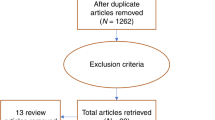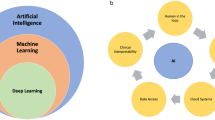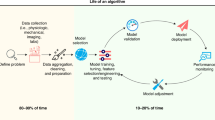Abstract
Background
With the development of Artificial Intelligence (AI) techniques, smart health monitoring, particularly neonatal cardiorespiratory monitoring with wearable devices, is becoming more popular. To this end, it is crucial to investigate the trend of AI and wearable sensors being developed in this domain.
Methods
We performed a review of papers published in IEEE Xplore, Scopus, and PubMed from the year 2000 onwards, to understand the use of AI for neonatal cardiorespiratory monitoring with wearable technologies. We reviewed the advances in AI development for this application and potential future directions. For this review, we assimilated machine learning (ML) algorithms developed for neonatal cardiorespiratory monitoring, designed a taxonomy, and categorised the methods based on their learning capabilities and performance.
Results
For AI related to wearable technologies for neonatal cardio-respiratory monitoring, 63% of studies utilised traditional ML techniques and 35% utilised deep learning techniques, including 6% that applied transfer learning on pre-trained models.
Conclusions
A detailed review of AI methods for neonatal cardiorespiratory wearable sensors is presented along with their advantages and disadvantages. Hierarchical models and suggestions for future developments are highlighted to translate these AI technologies into patient benefit.
Impact
-
State-of-the-art review in artificial intelligence used for wearable neonatal cardiorespiratory monitoring.
-
Taxonomy design for artificial intelligence methods.
-
Comparative study of AI methods based on their advantages and disadvantages.
Similar content being viewed by others
Log in or create a free account to read this content
Gain free access to this article, as well as selected content from this journal and more on nature.com
or
Data availability
Data sharing is not applicable to this article as no data sets were generated or analysed during the current study.
References
United Nations Department of Economic and Social Affairs. Goal 3: ensure healthy lives and promote well-being for all at all ages. https://sdgs.un.org/goals/goal3 (2021).
UNICEF. Neonatal mortality. https://data.unicef.org/topic/child-survival/neonatal-mortality/ (2020).
World Health Organisation. Newborn death and illness. https://www.who.int/pmnch/media/press_materials/fs/fs_newborndealth_illness/en/ (2020).
World Health Organisation. Newborns: improving survival and well-being. https://www.who.int/news-room/fact-sheets/detail/newborns-reducing-mortality (2020).
World Health Organisation. Preterm birth. https://www.who.int/news-room/fact-sheets/detail/preterm-birth (2022).
Daly, J., Monasterio, V. & Clifford, G. D. A neonatal apnoea monitor for resource-constrained environments. In Proc. 2012 Computing in Cardiology 321–324 (IEEE, 2012).
Gleason, C. A. & Juul, S. E. Avery’s Diseases of the Newborn E-book (Elsevier Health Sciences, 2017).
Acharya, S. et al. Ensemble learning approach via kalman filtering for a passive wearable respiratory monitor. IEEE J. Biomed. Health Inform. 23, 1022–1031 (2018).
Abreu, V., Oliveira, A., Duarte, J. A. & Marques, A. Computerized respiratory sounds in paediatrics: a systematic review. Respir. Med. 3, 100027 (2021).
DeGroff, C. G. et al. Artificial neural network–based method of screening heart murmurs in children. Circulation 103, 2711–2716 (2001).
Vu, H. et al. Automatic classification of resuscitation activities on birth-asphyxiated newborns using acceleration and ECG signals. Biomed. Signal Process. Control 36, 20–26 (2017).
Gómez-Quintana, S. et al. A framework for AI-assisted detection of patent ductus arteriosus from neonatal phonocardiogram. Healthcare 9, 169 (2021).
Bardou, D., Zhang, K. & Ahmad, S. M. Lung sounds classification using convolutional neural networks. Artif. Intell. Med. 88, 58–69 (2018).
Ranjit, S. & Kissoon, N. Challenges and solutions in translating sepsis guidelines into practice in resource-limited settings. Transl. Pediatr. 10, 2646 (2021).
Patron, D. et al. On the use of knitted antennas and inductively coupled RFID tags for wearable applications. IEEE Trans. Biomed. Circuits Syst. 10, 1047–1057 (2016).
Mongan, W. M. et al. Real-time detection of apnea via signal processing of time-series properties of RFID-based smart garments. In Proc. 2016 IEEE Signal Processing in Medicine and Biology Symposium (SPMB) 1–6 (IEEE, 2016).
de Greef, L. Using Consumer Devices to Monitor Acute Medical Conditions for Infants. PhD thesis, Univ. Washington (2019).
Munz, M. & Wolf, N. Simulation of breathing patterns and classification of sensor data for the early detection of impending sudden infant death. Curr. Direct. Biomed. Eng. 5, 401–403 (2019).
Raknim, P. et al. On the use of low-cost sensors for non-intrustive newborn sepsis monitoring. In WearSys '19: The 5th ACM Workshop on Wearable Systems and Applications 39–40 (ACM, 2019).
Urdal, J. et al. Automatic identification of stimulation activities during newborn resuscitation using ECG and accelerometer signals. Comput. Methods Prog. Biomed. 193, 105445 (2020).
Ostojic, D. et al. Reducing false alarm rates in neonatal intensive care: a new machine learning approach. Adv. Exp. Med. Biol. 1232, 285–290 (2020).
Shamsir, S., Hassan, O. & Islam, S. K. Smart infant-monitoring system with machine learning model to detect physiological activities and ambient conditions. In Proc. 2020 IEEE International Instrumentation and Measurement Technology Conference (I2MTC) 1–6 (IEEE, 2020).
Xu, S. et al. Wireless skin sensors for physiological monitoring of infants in low-income and middle-income countries. Lancet Digital Health 3, e266–e273 (2021).
Hansen, S. et al. Fusion learning on multiple-tag RFID measurements for respiratory rate monitoring. Proc. IEEE Int. Symp. Bioinformatics Bioeng. 2020, 472–480 (2020).
Vahabi, N. et al. Deep analysis of EIT dataset to classify apnea and non-apnea cases in neonatal patients. IEEE Access 9, 25131–25139 (2021).
Khodadad, D. et al. Optimized breath detection algorithm in electrical impedance tomography. Physiol. Meas. 39, 094001 (2018).
Gómez, R., García, N., Collantes, G., Ponce, F. & Redon, P. Development of a non-invasive procedure to early detect neonatal sepsis using HRV monitoring and machine learning algorithms. In Proc. 2019 IEEE 32nd International Symposium on Computer-Based Medical Systems (CBMS) 132–137 (IEEE, 2019).
Mahmud, M. S., Wang, H. & Kim, Y. Accelerated prediction of bradycardia in preterm infants using time-frequency analysis. In Proc. 2019 International Conference on Computing, Networking and Communications (ICNC) 468–472 (IEEE, 2019).
Macfarlane, P. W. & Kennedy, J. Automated ECG interpretation—a brief history from high expectations to deepest. Netw. Hearts 2, 433–448 (2021).
Villarroel, M. et al. Non-contact physiological monitoring of preterm infants in the neonatal intensive care unit. NPJ Digital Med. 2, 1–18 (2019).
Hunter, R. B. et al. Supervised machine learning applied to automate flash and prolonged capillary refill detection by pulse oximetry. Front. Physiol. 11, 564589 (2020).
Huang, B. et al. A neonatal dataset and benchmark for non-contact neonatal heart rate monitoring based on spatio-temporal neural networks. Eng. Appl. Artif. Intell. 106, 104447 (2021).
Amiri, A. M., Armano, G., Rahmani, A. M. & Mankodiya, K. PhonoSys: mobile phonocardiography diagnostic system for newborns. In Proc. 5th EAI International Conference on Wireless Mobile Communication and Healthcare (EAI, 2015).
Bokov, P., Mahut, B., Flaud, P. & Delclaux, C. Wheezing recognition algorithm using recordings of respiratory sounds at the mouth in a pediatric population. Comput. Biol. Med. 70, 40–50 (2016).
Solà, J. et al. Towards an unsupervised device for the diagnosis of childhood pneumonia in low resource settings: automatic segmentation of respiratory sounds. Annu. Int. Conf. IEEE Eng. Med. Biol. Soc. 2016, 283–286 (2016).
Shelevytsky, I., Shelevytska, V., Golovko., V. & Semenov, B. Segmentation and parametrization of the phonocardiogram for the heart conditions classification in newborns. In Proc. 2018 IEEE Second International Conference on Data Stream Mining & Processing (DSMP) 430–433 (IEEE, 2018).
Ramanathan, A. et al. Digital stethoscopes in paediatric medicine. Acta Paediatr. 108, 814–822 (2019).
Grooby, E. et al. Neonatal heart and lung sound quality assessment for robust heart and breathing rate estimation for telehealth applications. IEEE J. Biomed. Health Inform. 25, 4255–4266 (2020).
Gómez-Quintana, S., Shelevytsky, I., Shelevytska, V., Popovici, E. & Temko, A. Automatic segmentation for neonatal phonocardiogram. Annu. Int. Conf. IEEE Eng. Med. Biol. Soc. 2021, 135–138 (2021).
Jani, V. et al. The discerning ear: cardiac auscultation in the era of artificial intelligence and telemedicine. Eur. Heart J. Digital Health 2, 456–466 (2021).
Oliveira, M., Oliveira, J., Camacho, R. & Ferreira, C. A. A multi-spot murmur sound detection algorithm and its application to a pediatric and neonate population. In Proc. 14th International Joint Conference on Biomedical Engineering Systems and Technologies (BIOSTEC 2021), Vol. 4 228–234 (IEEE, 2021).
Grooby, E. et al. Real-time multi-level neonatal heart and lung sound quality assessment for telehealth applications. IEEE Access 10, 10934–10948 (2022).
Grooby, E. et al. A new non-negative matrix co-factorisation approach for noisy neonatal chest sound separation. In Proc. 2021 43rd Annual International Conference of the IEEE Engineering in Medicine & Biology Society (EMBC) 5668–5673 (IEEE, 2021).
Rinta-Koski O-P, Särkkä S, Hollmen J, Andersson S. Prediction of preterm infant mortality with Gaussian process classification. 2017:193-198.
Pais, C. M. & Arévalo González, S. in Applied Computer Sciences in Engineering. WEA 2017. Communications in Computer and Information Science, Vol. 742 (eds Figueroa-García, J., López-Santana, E., Villa-Ramírez, J., Ferro-Escobar, R.) 667–678 (Springer, 2017).
Jalali, A., Simpao, A. F., Gálvez, J. A., Licht, D. J. & Nataraj, C. Prediction of periventricular leukomalacia in neonates after cardiac surgery using machine learning algorithms. J. Med. Syst. 42, 1–11 (2018).
Joshi, R. et al. Predictive monitoring of critical cardiorespiratory alarms in neonates under intensive care. IEEE J. Transl. Eng. Health Med. 7, 1–10 (2019).
Hassan, O., Parvin, D. & Kamrul, S. Machine learning model based digital hardware system design for detection of sleep apnea among neonatal infants. In Proc. 2020 IEEE 63rd International Midwest Symposium on Circuits and Systems (MWSCAS) 607–610 (IEEE, 2020).
Pini, N. Physiology Based Machine Learning and Data Analytics for Perinatal Monitoring-a Novel Framework for a Comprehensive Maternal, Fetal, and Neonatal Profiling. Doctoral dissertation, Politecnico di Milano (2020).
Zuzarte, I., Sternad, D. & Paydarfar, D. Predicting apneic events in preterm infants using cardio-respiratory and movement features. Comput. Methods Prog. Biomed. 209, 106321 (2021).
Cabrera-Quiros, L. et al. Prediction of late-onset sepsis in preterm infants using monitoring signals and machine learning. Crit. Care Explor. 3, e0302 (2021).
Chisi, T. F. T. Determining the Potential of Wearable Technologies Within the Disease Landscape of Sub-Saharan Africa (Stellenbosch University, 2019).
Tandon, A., De & Ferranti, S. D. Wearable biosensors in pediatric cardiovascular disease: promises and pitfalls toward generating actionable insights. Circulation 140, 350–352 (2019).
Chong, N. K., Elaine, C. C. S. & de Korne, D. F. Creating a learning televillage and automated digital child health ecosystem. Pediatr. Clin. 67, 707–724 (2020).
Goulooze, S. C. et al. Beyond the randomized clinical trial: innovative data science to close the pediatric evidence gap. Clin. Pharmacol. Ther. 107, 786–795 (2020).
Johnson, K. T. & Picard, R. W. Advancing neuroscience through wearable devices. Neuron 108, 8–12 (2020).
Memon, S. F., Memon, M. & Bhatti, S. Wearable technology for infant health monitoring: a survey. IET Circuits Devices Syst. 14, 115–129 (2020).
Hasan, N. & Negulescu, I. Wearable technology for baby monitoring: a review. J. Text. Eng. Fash. Technol. 6, 15406 (2020).
Sobhan, S., Islam, S., Valero, M., Shahriar, H. & Ahamed, S. I. Data analysis methods for health monitoring sensors: a survey. In Proc. 2021 IEEE 45th Annual Computers, Software, and Applications Conference (COMPSAC) 669–676 (IEEE, 2021).
Lin, J. et al. Wearable sensors and devices for real-time cardiovascular disease monitoring. Cell Rep. Phys. Sci. 2, 100541 (2021).
Lyu, Q., Gong, S., Yin, J., Dyson, J. M. & Cheng, W. Soft wearable healthcare materials and devices. Adv. Healthc. Mater. 10, 2100577 (2021).
Funding
E.G. acknowledges the support of the MIME-Monash Partners-CSIRO sponsored PhD research support programme and Research Training Program (RTP). T.C.K. and D.S. are supported by the National Institute of Health Research (NIHR) Children and Young People MedTech Co-operative (CYP MedTech). D.S. has received funding for technology development from the Medical Research Council, NIHR and Action Medical Research, and is a non-executive director of SurePulse Medical who are developing monitoring solutions for neonatal care. A.M.’s research is supported by the NHMRC (Aus) and Cerebral Palsy Alliance. The study is supported by the Monash Institute of Medical Engineering (MIME). The views expressed are those of the author(s) and not necessarily those of the NHS, the NIHR or of the Department of Health.
Author information
Authors and Affiliations
Contributions
Substantial contributions to conception and design, acquisition of data, or analysis and interpretation of data; drafting the article or revising it critically for important intellectual content; final approval of the version to be published: all authors.
Corresponding author
Ethics declarations
Competing interests
The authors declare no competing interests.
Ethics approval and consent to participate
Patient consent was not required.
Additional information
Publisher’s note Springer Nature remains neutral with regard to jurisdictional claims in published maps and institutional affiliations.
Supplementary information
Rights and permissions
Springer Nature or its licensor (e.g. a society or other partner) holds exclusive rights to this article under a publishing agreement with the author(s) or other rightsholder(s); author self-archiving of the accepted manuscript version of this article is solely governed by the terms of such publishing agreement and applicable law.
About this article
Cite this article
Sitaula, C., Grooby, E., Kwok, T.C. et al. Artificial intelligence-driven wearable technologies for neonatal cardiorespiratory monitoring. Part 2: artificial intelligence. Pediatr Res 93, 426–436 (2023). https://doi.org/10.1038/s41390-022-02417-w
Received:
Revised:
Accepted:
Published:
Issue date:
DOI: https://doi.org/10.1038/s41390-022-02417-w
This article is cited by
-
Hybrid multimodal wearable sensors for comprehensive health monitoring
Nature Electronics (2024)
-
Artificial Intelligence in Medical Metaverse: Applications, Challenges, and Future Prospects
Current Medical Science (2024)
-
Early prediction of need for invasive mechanical ventilation in the neonatal intensive care unit using artificial intelligence and electronic health records: a clinical study
BMC Pediatrics (2023)



